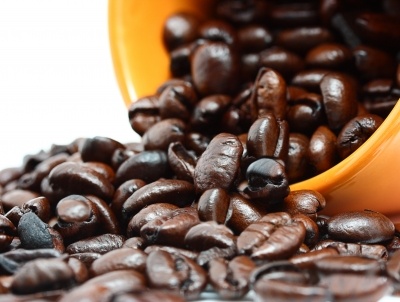
At a recent conference on managing waste fruit materials, a supplier commented on research efforts directed to using coffee bean waste. One of the issues for the coffee processing industry is the increasing amount of sub-standard coffee beans, be they immature, damaged or judged unsuitable for further processing such as roasting. Could sub-standard coffee beans provide a source of antioxidants as well as caffeine and some important diterpenes, and were there any other uses for spent grounds for example ?
Coffee antioxidants are well researched, and the majority are chlorogenic acids which makes the beverage, one of the highest known for such components . Roasting mainly destroys the antioxidant potential by reducing the chlorogenic acid potential (del Castillo et al., 2002) so keeping the waste beans as ‘green’ coffee should ensure no further losses prior to extraction. There is some evidence that unless coffee consumption is moderate, it is associated with increases in a number of risk factors associated with cardiovascular disease. For example, raised blood pressure and an increase in total plasma homocysteine levels (Higdon and Frei, 2006). The mechanisms are currently being worked out. On the other hand, coffee consumption may reduce insulin resistance which implies a reduction in the incidence of type 2 diabetes and in inflammation markers (Lopez-Garcia et al., 2006; van Dam et al., 2006). It is worth accessing the web-site www.coffeeandhealth.org for a wealth of articles on the subject because individual or groups of factors in the componentry of coffee beans might be usefully exploited or at least avoided where issues are identified.
Production of industrially useful materials from wastes using environmentally friendly processes is an ideal way to make use of unused or spent coffee beans. The coffee beans and their grounds have been used for the production of activated carbon using steam activation (Nakagawa et al., 2001; Boonamnuayvitaya et al., 2004a) which have subsequently been tested for the adsorption of heavy metals, formaldehyde (Boonamnuayvitaya et al., 2004b, 2005; Kaikake et al., 2007), phenols (Nakagawa et al., 2004), industrial dyes such as malachite green (Baek et al., 2010) and as carbon electrodes in capacitors (Rufford et al., 2008, 2009).
This article scratches the surface on the benefits of using waste green coffee beans and provides only a snap shot on the subject, I’m aiming to maintain a series of posts looking at how waste food materials are being used. When I started writing this post, it was apparent that a large body of evidence is being accumulated on its benefits and each nutritional state deserves appropriate coverage. This element I also hope to address in the future.
References
Baek, M.-H., Ijagbemi, C.O., O, S.-J., Kim, D.-S. (2010) Removal of Malachite Green from aqueous solution using degreased coffee bean. J. Hazardous Materials 176 pp. 820-828
Boonamnuayvitaya, V., Chaiya, C., Tanthanpanichakoon, W., 2004a. The preparation and characterization of activated carbon from coffee residue. J. Chem. Eng. Japan. 37, pp. 1504–1512.
Boonamnuayvitaya, V., Chaiya, C., Tanthapanichakoon, W., Jarudilokkul, 2004b. Removal of heavy metals by adsorbent prepared from pyrolyzed coffee residues and clay. Separation and Purification Technology 42, pp. 11–22.
Boonamnvayvitaya, V., Sae-Ung, S., Tanthapanichakoon, W., 2005. Preparation of activated carbons from coffee residue for the adsorption of formaldehyde. Separation and Purification Technology 42, pp. 159–168.
del Castillo MD, Ames JM, Gordon MH.(2002) Effect of roasting on the antioxidant activity of coffee brews. J. Agric Food Chem. 50 pp. 3698-3703.
Higdon, J.V., Frei, B. (2006) Coffee and health: A review of recent human research. Crit. Rev. Food Sci. Nutr. 46, pp. 101-123
Kaikake,K., Hoaki, K., Sunada, H., Dhakal, R.P., Baba, Y. (2007) Removal characteristics of metal ions using degreased coffee beans: adsorption equilibrium of cadmium(II). Bioresour. Technol. 98 pp. 2787–2791.
Lopez-Garcia, E., van Dam, R.M., Qi, L., Hu, F.B. (2006) Coffee consumption and markers of inflammation and endothelial dysfunction in healthy and diabetic women. Am. J. Clin. Nutr. 84 pp. 888–893
Nabais, J. M. V., Nunes, P., Carrott, P. J. M., Ribeiro-Carrott, M. M. L., Macías-García, A., Díaz-Díez, M. A. (2008) Production of Activated Carbons from Coffee Endocarp by CO2 and Steam Activation. Fuel Process. Technol. 89, pp. 262.
Nakagawa, K., Fuke, A., Tamon, H., Suzuki, T., Nagano, S. (2001) Preparation of activated carbons from waste coffee beans. Jpn. J. Food Eng. 2, pp. 141–6.
Nakagawa, K., Namba, A., Mukai, S.R., Tamon, H., Ariyadejwanich, P., Tanthapanichakoon, W. (2004) Adsorption of phenol and reactive dye from aqueous solution on activated carbons derived from solid wastes. Water Res. 38 pp. 1791–8.
Olthof, M.R., Hollman, P.C.H., Zock, P., Katan, M.B. (2001). Consumption of high doses of chlorogenic acid, present in coffee, or of black tea increases plasma total homocysteine concentrations in humans. Am. J. Clin. Nutr. 73, pp. 532 – 538.
Rufford, T.E., Hulicova-Jurcakova, D., Zhu, Z., Lu, G.Q. (2008) Nanoporous carbon electrode from waste coffee beans for high performance supercapacitors. Electrochem. Commun. 10(10) pp. 1594 – 1597.
_____________________________, Fiset, E., Zhu, Z. Lu, G.Q. (2009) Double-Layer capacitance Of waste coffee ground activated carbons in an organic electrolyte. Electrochem. Commun. 11(5) pp. 974-977
van Dam RM, Willett WC, Manson JE, Hu FB (2006) Coffee, caffeine, and risk of type 2 diabetes: a prospective cohort study in younger and middle-aged U.S. women. Diabetes Care 29 pp.398–403
Hi Alister Samson Smith,
Please could you advise on what to do with spent coffee beans, as the natural chemical content could be a problem !..
Kind Regards
Andrew Wood (Aardvark waste Services).
Valuable info. Fortunate me I found your web site unintentionally, and I am stunned
why this coincidence didn’t came about earlier! I
bookmarked it.